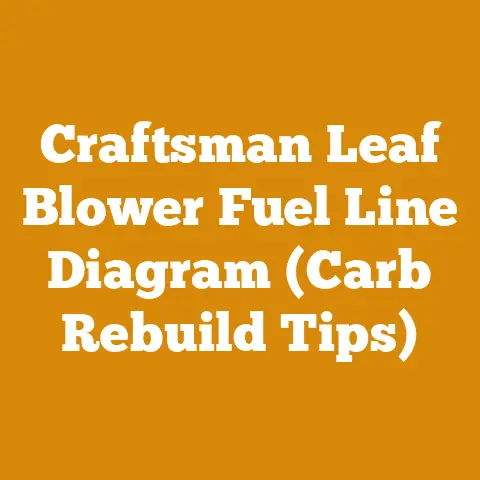Does a Wood Stove Pipe Have to Go Straight Up? (5 Expert Tips)
The biting chill of a late autumn evening, the scent of woodsmoke mingling with the crisp air, the comforting crackle of a fire – these are the sensations that draw me back to wood stoves, year after year. There’s a primal connection we humans have with fire, a warmth that goes beyond just physical comfort. But that warmth only comes when everything’s working right, and that starts with the chimney. I remember one particularly frustrating winter when my old stove just wouldn’t draw properly. The smoke billowed back into the room, leaving a sooty film on everything and a lingering smell that clung to my clothes. After a lot of head-scratching and some choice words, I finally realized the problem: the chimney wasn’t straight enough. It sparked a whole new understanding of how crucial proper stove pipe installation is. So, does a wood stove pipe have to go straight up? Well, the answer is a bit more nuanced than a simple yes or no. Let’s dive in and explore this crucial aspect of wood stove installation, sharing some expert tips I’ve learned over the years to ensure your wood stove burns efficiently and, most importantly, safely.
Does a Wood Stove Pipe Have to Go Straight Up? (5 Expert Tips)
While the ideal scenario is a straight, vertical chimney, the reality is that many installations require some degree of offset. So, the short answer is no, a wood stove pipe doesn’t absolutely have to go straight up, but straight is always best. Let me explain why, and then we’ll cover those crucial tips.
A straight chimney creates the strongest draft. Think of it like a highway for smoke. A clear, unobstructed path allows hot gases to rise quickly and efficiently, pulling fresh air into the stove and ensuring a clean, complete burn. Any bends or elbows introduce resistance, slowing down the draft and potentially leading to smoke backdraft, creosote buildup, and reduced heating efficiency.
However, architectural constraints or existing flue setups often necessitate using angled sections. The key is to minimize the number of bends and ensure they are installed correctly to maintain adequate draft. Let’s explore how to achieve this.
Tip #1: Understanding the Importance of Draft
Draft is the lifeblood of your wood stove. It’s the force that pulls air into the stove, fuels the fire, and carries the exhaust gases up and out of your home. Insufficient draft leads to a smoky fire, inefficient burning, and a higher risk of carbon monoxide poisoning.
Several factors influence draft, including:
- Chimney Height: A taller chimney generally creates a stronger draft. Building codes typically specify a minimum chimney height above the roofline to ensure adequate draft.
- Chimney Diameter: The chimney’s diameter should match the stove’s flue outlet. An undersized chimney restricts airflow, while an oversized chimney can cool the exhaust gases too quickly, leading to creosote buildup.
- Temperature Difference: The greater the temperature difference between the inside of the chimney and the outside air, the stronger the draft. This is why wood stoves often perform better in colder weather.
- Obstructions: Any obstructions in the chimney, such as bird nests, creosote buildup, or improper damper settings, can impede draft.
I once helped a friend troubleshoot a persistent smoke backdraft issue. After checking everything else, we discovered a bird’s nest lodged halfway down the chimney. Removing it instantly solved the problem. It was a smelly job, but a valuable lesson in the importance of regular chimney inspections!
Tip #2: Minimizing Offsets and Bends
The fewer bends in your stove pipe, the better. Each bend reduces draft and increases the risk of creosote accumulation. If offsets are unavoidable, follow these guidelines:
- Limit the Angle: Aim for a maximum offset angle of 45 degrees. Steeper angles significantly impede draft.
- Keep Runs Short: Horizontal runs (sections of pipe that are not vertical) should be as short as possible. Ideally, they should not exceed 75% of the vertical height of the chimney. For every foot of horizontal run, you need to add a corresponding amount of vertical height to maintain adequate draft.
- Use Smooth Elbows: Avoid using sharp 90-degree elbows. Instead, opt for two 45-degree elbows or a single adjustable elbow to create a smoother transition.
- Consider a Chimney Liner: If you’re connecting your stove to an existing masonry chimney, a stainless steel chimney liner is highly recommended. Liners provide a smooth, consistent flue diameter, improve draft, and prevent corrosive flue gases from damaging the chimney structure.
I remember working on a cabin installation where the existing chimney had a significant offset due to a structural beam. We used two 45-degree elbows and a short horizontal run to navigate the obstacle. To compensate for the reduced draft, we installed a taller chimney section above the roofline. It required a bit of extra work, but it resulted in a safe and efficient installation.
Tip #3: Choosing the Right Stove Pipe Material
The material of your stove pipe is crucial for safety and performance. Single-wall stove pipe is commonly used to connect the stove to the chimney, but it should never be used to pass through a wall or ceiling.
- Single-Wall Stove Pipe: This is the most common and affordable option. It’s typically made of 24-gauge or 22-gauge steel and is suitable for connecting the stove to the chimney in the same room. However, single-wall pipe radiates a lot of heat, making it a potential fire hazard if placed too close to combustible materials.
- Double-Wall Stove Pipe (aka “Double-Wall Connector Pipe”): This type of pipe has two layers of steel with an air space in between. This reduces the surface temperature of the pipe, making it safer to use closer to walls and ceilings. It also helps to improve draft by keeping the exhaust gases hotter.
- Triple-Wall Stove Pipe: Some manufacturers offer triple-wall stove pipe for even greater safety and insulation.
- Stainless Steel Chimney Liner: As mentioned earlier, a stainless steel chimney liner is essential for connecting a wood stove to a masonry chimney. It provides a smooth, corrosion-resistant flue and improves draft.
I once saw a homeowner use single-wall stove pipe to pass through a wall to connect to a chimney in another room. It was a disaster waiting to happen. The single-wall pipe got incredibly hot, posing a serious fire risk. I strongly advised them to replace it with a proper through-the-wall kit with insulated double-wall pipe.
Important Note: Always follow the manufacturer’s instructions and local building codes when selecting and installing stove pipe.
Tip #4: Proper Installation Techniques
Proper installation is paramount for a safe and efficient wood stove system. Here are some key considerations:
- Clearances to Combustibles: Maintain the minimum clearances to combustible materials specified by the stove and pipe manufacturers. This is critical to prevent fires. Use heat shields if necessary to reduce clearances.
- Secure Connections: Ensure that all stove pipe sections are securely connected using screws or clamps. Loose connections can leak smoke and carbon monoxide.
- Proper Support: Support the stove pipe properly to prevent it from sagging or collapsing. Use pipe supports or brackets as needed.
- Thimble Installation: When passing through a wall or ceiling, use a listed and labeled thimble. A thimble is a fire-resistant sleeve that protects the surrounding structure from the heat of the stove pipe.
- Chimney Cap: Install a chimney cap to prevent rain, snow, and debris from entering the chimney. A chimney cap also helps to improve draft by deflecting wind.
- Professional Inspection: After installation, have a qualified professional inspect your wood stove system to ensure it meets safety standards and is functioning properly.
I always double-check the clearances to combustibles before firing up a newly installed stove. It’s a simple step that can prevent a potentially devastating fire. Use a laser measuring tool for accuracy.
Tip #5: Regular Maintenance and Inspection
Regular maintenance is essential for keeping your wood stove system safe and efficient.
- Chimney Sweeping: Have your chimney professionally swept at least once a year, or more frequently if you burn a lot of wood. Creosote buildup is a major fire hazard.
- Visual Inspections: Regularly inspect your stove pipe and chimney for signs of damage, corrosion, or creosote buildup.
- Damper Check: Ensure that the damper is functioning properly. A stuck or damaged damper can impede draft and increase the risk of smoke backdraft.
- Door Seal Inspection: Check the door seal regularly. A worn or damaged seal can allow air to leak into the stove, reducing efficiency.
- Ash Removal: Remove ashes regularly to prevent them from accumulating and blocking airflow.
I make it a habit to inspect my chimney every fall before the heating season begins. I use a chimney brush to remove any loose creosote and check for cracks or damage. It’s a dirty job, but it’s worth it for the peace of mind.
Creosote: The Silent Killer
Creosote is a highly flammable substance that forms when wood smoke condenses in the chimney. It’s a black or brown tar-like residue that can accumulate quickly, especially when burning unseasoned wood or operating the stove at low temperatures.
There are three stages of creosote:
- Stage 1: A light, flaky deposit that is relatively easy to remove.
- Stage 2: A hard, tar-like deposit that is more difficult to remove.
- Stage 3: A thick, glossy deposit that is extremely flammable and can be very difficult to remove.
A chimney fire occurs when creosote ignites in the chimney. Chimney fires can be extremely dangerous, causing significant damage to your home and potentially spreading to surrounding structures.
Data Point: According to the National Fire Protection Association (NFPA), heating equipment is a leading cause of home fires in the United States, and creosote buildup is a major contributing factor. Regular chimney sweeping is the best way to prevent chimney fires.
Wood Species and Creosote:
The type of wood you burn also affects creosote buildup. Softwoods like pine and fir tend to produce more creosote than hardwoods like oak and maple. This is because softwoods contain more resin, which contributes to creosote formation.
Case Study: The Importance of Seasoned Wood
I once consulted with a homeowner who was experiencing excessive creosote buildup in their chimney. They were burning primarily green pine, which is notorious for producing creosote. I advised them to switch to seasoned hardwoods and to burn the stove at higher temperatures. Within a few weeks, the creosote buildup had significantly decreased.
The Magic of Seasoning:
Seasoning wood involves allowing it to dry for at least six months, preferably longer. This reduces the moisture content of the wood, making it burn hotter and cleaner. Seasoned wood also produces less smoke and creosote.
Data Point: Seasoned wood typically has a moisture content of 20% or less, while green wood can have a moisture content of 50% or higher.
Tools of the Trade:
- Moisture Meter: A moisture meter is a valuable tool for measuring the moisture content of firewood.
- Chimney Brush: A chimney brush is essential for cleaning your chimney. Choose a brush that is the correct size and shape for your chimney.
- Chimney Camera: A chimney camera can be used to inspect your chimney for cracks, damage, or creosote buildup.
Safety First!
Always wear safety glasses, gloves, and a dust mask when cleaning your chimney. And remember, if you’re not comfortable cleaning your chimney yourself, hire a qualified professional.
Additional Considerations for Optimal Performance
Beyond the core tips, here are some additional considerations that can significantly improve your wood stove’s performance and lifespan:
- Barometric Dampers: In areas with strong or variable winds, a barometric damper can help regulate the draft and prevent overfiring. These dampers automatically adjust to changes in air pressure, ensuring a consistent and safe burn.
- Outside Air Kits: If your home is tightly sealed, an outside air kit can provide a dedicated source of combustion air for your stove. This prevents the stove from drawing air from inside the house, which can lead to drafts and reduced heating efficiency.
- Catalytic Combustors: Some wood stoves are equipped with catalytic combustors, which burn off smoke and gases before they exit the stove. This reduces emissions, improves efficiency, and minimizes creosote buildup. However, catalytic combustors require regular maintenance and replacement.
- Stove Placement: The location of your wood stove can also affect its performance. Avoid placing the stove in a drafty area or near a cold exterior wall. A central location will help to distribute heat more evenly throughout your home.
A Final Word on Wood Stove Safety
Wood stoves are a wonderful source of heat and ambiance, but they must be treated with respect. By following these tips and adhering to safety guidelines, you can enjoy the warmth and comfort of a wood stove without compromising your safety. Always remember to prioritize safety, maintain your equipment, and burn responsibly. The warmth of a crackling fire is a reward worth earning, and with the right knowledge and preparation, you can enjoy it for years to come.






